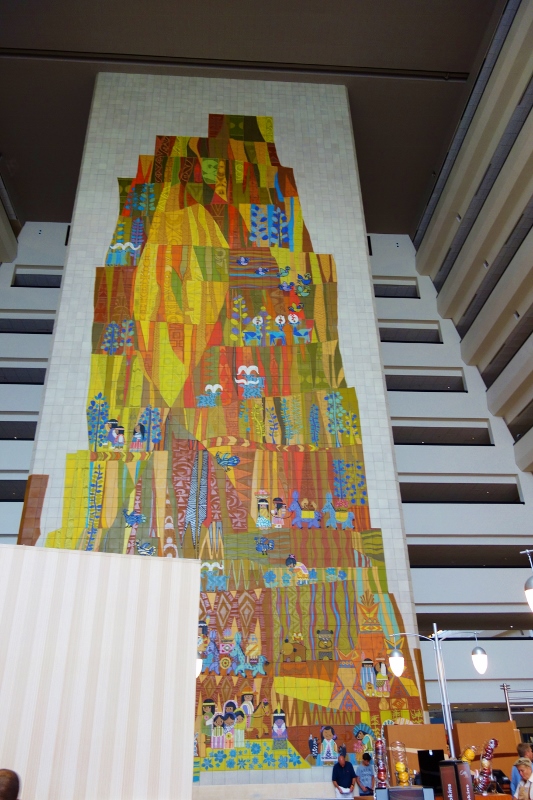A Friday Visit with Jim Korkis: Mary Blair’s Mural at the Contemporary Resort
By Dave Shute
Welcome back to Fridays with Jim Korkis! Jim, the dean of Disney historians and author of Jim’s Gems in The easy Guide, writes about Walt Disney World history every Friday on yourfirstvisit.net.
MARY BLAIR’S PUEBLO VILLAGE MURAL AT DISNEY’S CONTEMPORARY RESORT
By Jim Korkis
An artistic treasure at Walt Disney World is a mural in the Contemporary Resort done by Disney Legend Mary Blair.
Blair started at the Disney Studio in 1940 and contributed her unique color and design work to films that included The Three Caballeros (1945), Song of the South (1946), Cinderella (1950), Alice in Wonderland (1951) Peter Pan (1953), and many more. In particular, she was perhaps best known for her design work on the “it’s a small world” attraction.
Her massive ninety-foot tall mural encircles the elevator shafts of the Contemporary Resort, each wall telling a different part of the story of the children, animals, flora and geology of the Grand Canyon. Blair called the mural the “Pueblo Village”.
In 1966, Walt Disney gave Mary the opportunity to work for the first time with fired clays and textural color by hiring her to produce a 220 square foot ceramic mural for the Jules Stein Eye Institute at the UCLA Center for Health Services in Los Angeles.
Very pleased with the result, Walt then assigned her to produce two facing murals for the renovation of Disneyland’s Tomorrowland promenade that opened in 1967. They were each fifteen and a half feet high and fifty-four feet long and again featured her familiar children enjoying the future.

The architect Welton Becket, originally planned for the shafts to be encased in shiny metal, to capture a modern feeling.
Instead, Blair devised a more welcoming feel for the huge interior that was named the Grand Canyon Concourse. In 1971, the restaurants and bars in the hotel had related names like the Grand Canyon Terrace Café, El Pueblo Room, Mesa Grande Lounge and Outer Rim to suggest that natural wonder.
Each balcony was painted a different shade of earth tone to suggest the different layers of the canyon. It took eighteen months to design, produce and install the final mural that “hid” the elevators.
Blair was inspired by prehistoric petroglyphs, pueblo murals, Navajo ceremonial art and sand paintings. The colors were meant not just to suggest Native American art but earth and sky tones associated with the Grand Canyon.
Near the upper right of the mural that faces the monorail is a five-legged goat while all the other goats clearly have four legs. In their art, the Navajo have the concept of “purposely imperfect” to indicate that nothing man makes should be perfect because doing so would be an affront to the Great Spirit.
Blair used over 18,000 individually hand-painted, fire-glazed, one foot square ceramic tiles. High quality prints of her original design paintings for individual scenes were reproduced, framed and hung throughout the hotel, sometimes over the beds in each room. The prints were removed when the resort underwent a renovation in the early 1990s.
There is a photo of Blair looking over the layout of the tiles that were laid out on large tables in sections at WED in California. The tiles were shipped from California to Florida on special air-suspension trucks. When she saw the finished mural in Florida, she told writer Ross Care, “I walked into that giant concourse. My reaction was ‘Oh, wow!’”
* * * * *
Thanks, Jim! And come back next Friday for even more from Jim Korkis!
In the meantime, check out his books, including Secret Stories of Walt Disney World: Things You Never You Never Knew, which reprints much material first written for this site, and The Vault of Walt: Volume 4, and his contributions to The easy Guide to Your First Walt Disney World Visit, all published by Theme Park Press.
Follow yourfirstvisit.net on Facebook or Google+ or Twitter or Pinterest!!



0 comments
Comment by typing in the form below.
Leave a Comment | Ask a Question | Note a Problem